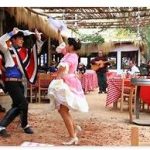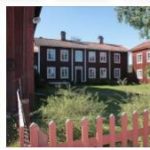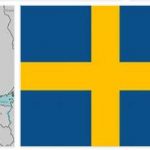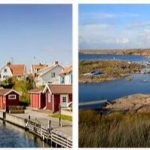The Sami have roamed Lapland as reindeer nomads since prehistoric times. The rock carvings of Tanum are depictions of hunting, everyday life and the myths of the Bronze Age. Runic writing was in use from the 2nd century AD up to the Middle Ages, and many stone inscriptions have survived. From Sweden from the 9th to the 11th centuries, the Varangians penetrated deep into Eastern Europe via the great rivers. Important trading bases of the Viking Age in Sweden itself were Birka and Hovgården on an island in Lake Mälaren. From the 12th century onwards, the Hanseatic city of Visby on the island of Gotland took over its role.
The Swedish art established itself with the emergence of a Swedish political system. Her main field of activity was church building, initially Romanesque, then in the form of brick Gothic (e.g. Uppsala Cathedral), and Gothic stone carving. Architectural treasures from later times are in particular castles and aristocratic palaces, including Kalmar (Renaissance), Skokloster, Stockholm (Baroque) and, as “Versailles of the North”, the former royal summer residence Drottningholm(Baroque, Rococo, Classicism). A master of the classical style was the sculptor JT Sergel . Functionalism became a seal of approval for Swedish architecture after the First World War. Wood is still used in house and settlement construction today. The Swedish “church villages” like Gammelstad in Luleå are an expression of Christian piety and community life in sparsely populated areas. The handicrafts and glass art from Småland, which flourished for the first time in the 18th century, continued in modern Swedish design, which in the second half of the 20th century became an internationally sought-after mass-produced item thanks to the IKEA furniture stores, among other things. In addition, the colorful patterns and decors of Swedish folk art (furniture, textiles) remained present.
A Swedish literature developed since the 14./15. Century. Rhyming chronicles and knight episodes stood at the beginning. Teaching poems and school dramas followed in the Baroque period. CM Bellman excelled at the end of the 18th century with popular and satirical songs. With literary modernism, Swedish literature gained European recognition: A. Strindberg shaped naturalistic drama. S. Lagerlöf is an important representative of neo-romanticism. She was the first woman to receive the Nobel Prize for Literature awarded by the Swedish Academy. Swedish crime fiction gained international renown with Sjöwall / Wahlöö and H. Mankell as a pacemaker. The children’s book author A. Lindgren became world famous with her unconventional heroines such as “Pippi Longstocking”, “Michel from Lönneberga” and “Ronja the robber’s daughter”. In music there was a similar »export hit« with the pop group ABBA. Art music only gained a foothold in Sweden at the end of the 18th century (Swedish music). It took up many folk elements – dance and choral music are to this day connecting elements of a national musical culture.
The silent film era was also shaped by the Swedish film industry. It was there that the later Hollywood diva G. Garbo started her career. The extensive oeuvre of director I. Bergman made its mark on the sound film of the second half of the 20th century.
In everyday Swedish culture, retreating to the countryside and experiencing nature play a major role. The individually designed leisure time in one’s own »summer house« is often juxtaposed with joint ventures organized by social and political organizations as a form of »democratic education«. The Swedes are particularly open to digitization. Popular sports are ice hockey, Nordic skiing and football.
In the fight against corona, politics and health authorities under the guidance of the chief virologist Anders Tegnell (* 1956) to infection as well as an immunization of the population as fast as possible that is reasonable for the health system. According to philosophynearby, Sweden went a separate way in Europe. Social and economic life was not subjected to a lockdown as it was in Europe. Schools, shops and restaurants remained open, and events for up to 50 people were allowed. The Swedish health authority recommended that citizens act independently, work more from home and reduce social contacts. No bans were issued. There was criticism of the weak leadership role of politics and the loose strategy of the health authority at home and abroad, especially from epidemiologists.









